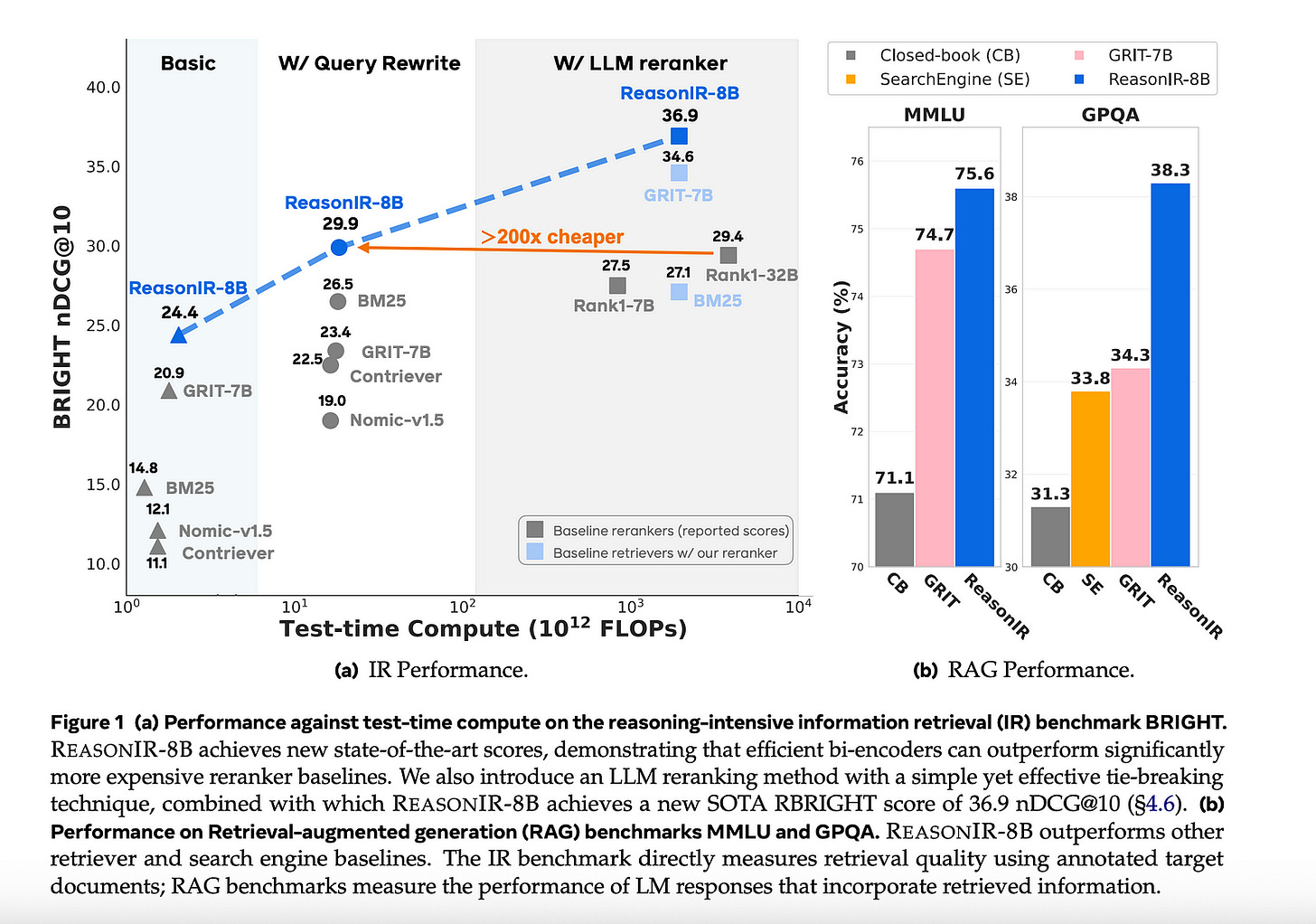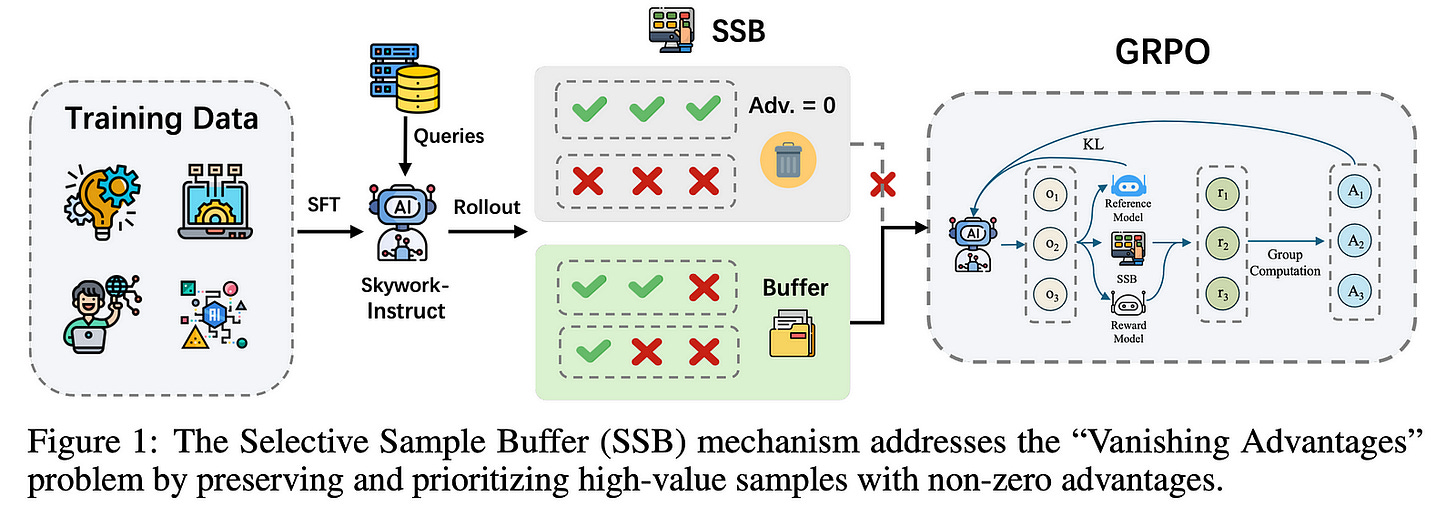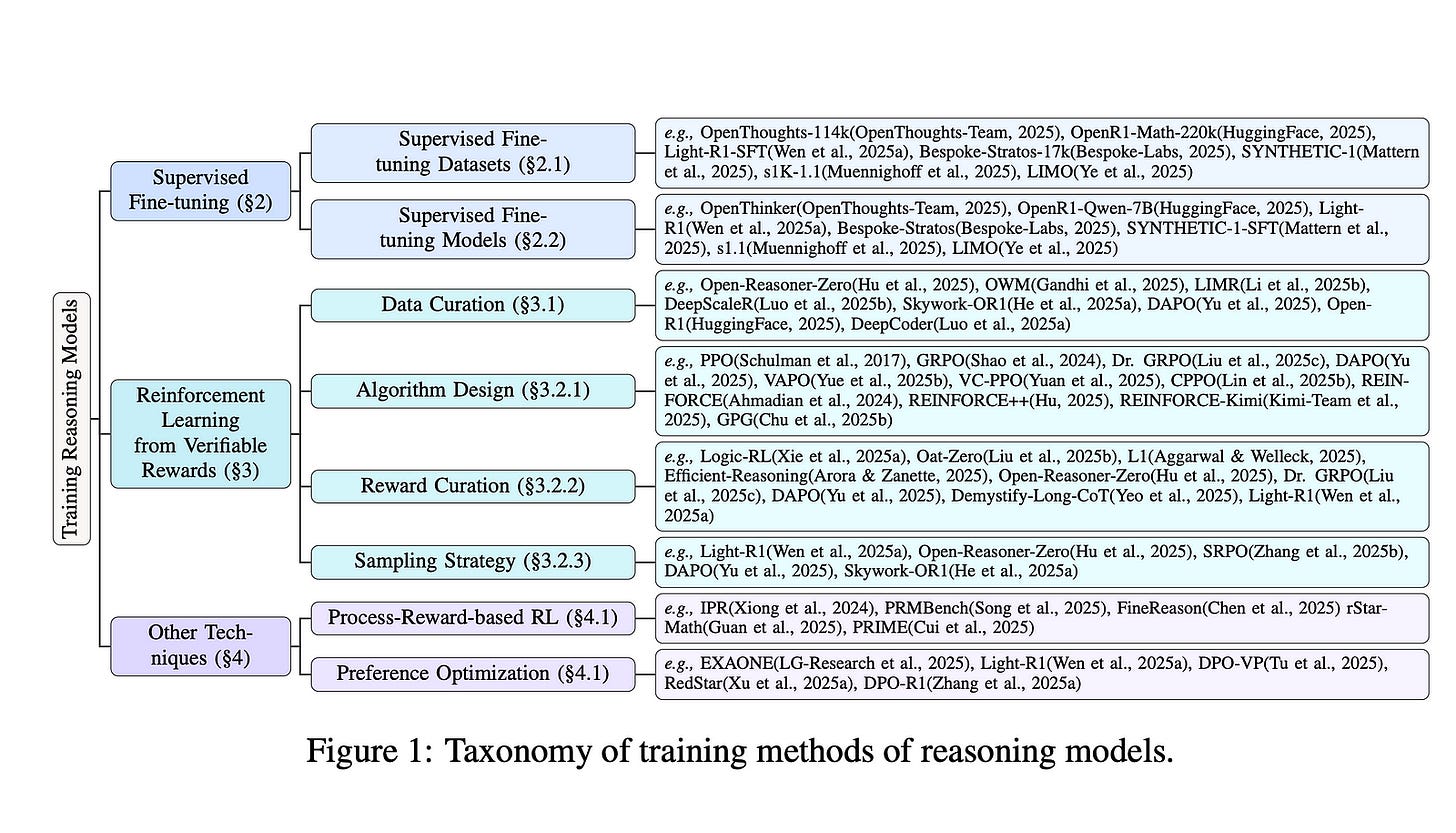Important LLM Papers for the Week From 28/04 to 03/05
Stay Updated with Recent Large Language Models Research
Large language models (LLMs) have advanced rapidly in recent years. As new generations of models are developed, researchers and engineers need to stay informed on the latest progress.
This article summarizes some of the most important LLM papers published during the Last Week of April 2025. The papers cover various topics shaping the next generation of language models, from model optimization and scaling to reasoning, benchmarking, and enhancing performance.
Keeping up with novel LLM research across these domains will help guide continued progress toward models that are more capable, robust, and aligned with human values.
Table of Contents:
LLM Progress & Technical Reports
LLM Reasoning
LLM Training & Fine-Tuning
Vision Language Models
My New E-Book: LLM Roadmap from Beginner to Advanced Level
I am pleased to announce that I have published my new ebook LLM Roadmap from Beginner to Advanced Level. This ebook will provide all the resources you need to start your journey towards mastering LLMs.
1. LLM Progress & Technical Reports
1.1. The Leaderboard Illusion
Measuring progress is fundamental to the advancement of any scientific field. As benchmarks play an increasingly central role, they also grow more susceptible to distortion. Chatbot Arena has emerged as the go-to leaderboard for ranking the most capable AI systems.
Yet, in this work, we identify systematic issues that have resulted in a distorted playing field. We find that undisclosed private testing practices benefit a handful of providers who are able to test multiple variants before public release and retract scores if desired.
We establish that the ability of these providers to choose the best score leads to biased Arena scores due to selective disclosure of performance results. At an extreme, we identify 27 private LLM variants tested by Meta in the lead-up to the Llama-4 release.
We also establish that proprietary closed models are sampled at higher rates (number of battles) and have fewer models removed from the arena than open-weight and open-source alternatives. Both these policies lead to large data access asymmetries over time.
Providers like Google and OpenAI have received an estimated 19.2% and 20.4% of all data in the arena, respectively. In contrast, a combined 83 open-weight models have only received an estimated 29.7% of the total data.
We show that access to Chatbot Arena data yields substantial benefits; even limited additional data can result in relative performance gains of up to 112% on the arena distribution, based on our conservative estimates. Together, these dynamics result in overfitting to Arena-specific dynamics rather than general model quality.
The Arena builds on the substantial efforts of both the organizers and an open community that maintains this valuable evaluation platform. We offer actionable recommendations to reform the Chatbot Arena’s evaluation framework and promote fairer, more transparent benchmarking for the field
1.2. Sadeed: Advancing Arabic Diacritization Through Small Language Model
Arabic text diacritization remains a persistent challenge in natural language processing due to the language’s morphological richness. In this paper, we introduce Sadeed, a novel approach based on a fine-tuned decoder-only language model adapted from Kuwain 1.5B Hennara et al. [2025], a compact model originally trained on diverse Arabic corpora.
Sadeed is fine-tuned on carefully curated, high-quality diacritized datasets, constructed through a rigorous data-cleaning and normalization pipeline. Despite utilizing modest computational resources, Sadeed achieves competitive results compared to proprietary large language models and outperforms traditional models trained on similar domains.
Additionally, we highlight key limitations in current benchmarking practices for Arabic diacritization. To address these issues, we introduce SadeedDiac-25, a new benchmark designed to enable fairer and more comprehensive evaluation across diverse text genres and complexity levels.
Together, Sadeed and SadeedDiac-25 provide a robust foundation for advancing Arabic NLP applications, including machine translation, text-to-speech, and language learning tools.
1.3. Clinical knowledge in LLMs does not translate to human interactions
Global healthcare providers are exploring the use of large language models (LLMs) to provide medical advice to the public. LLMs now achieve nearly perfect scores on medical licensing exams, but this does not necessarily translate to accurate performance in real-world settings.
We tested whether LLMs can assist members of the public in identifying underlying conditions and choosing a course of action (disposition) in ten medical scenarios in a controlled study with 1,298 participants. Participants were randomly assigned to receive assistance from an LLM (GPT-4o, Llama 3, Command R+) or a source of their choice (control).
Tested alone, LLMs complete the scenarios accurately, correctly identifying conditions in 94.9% of cases and disposition in 56.3% on average. However, participants using the same LLMs identified relevant conditions in less than 34.5% of cases and disposition in less than 44.2%, both no better than the control group.
We identify user interactions as a challenge to the deployment of LLMs for medical advice. Standard benchmarks for medical knowledge and simulated patient interactions do not predict the failures we find with human participants. Moving forward, we recommend systematic human user testing to evaluate interactive capabilities prior to public deployments in healthcare.
1.4. DeepCritic: Deliberate Critique with Large Language Models
As Large Language Models (LLMs) are rapidly evolving, providing accurate feedback and scalable oversight on their outputs becomes an urgent and critical problem.
Leveraging LLMs as critique models to achieve automated supervision is a promising solution. In this work, we focus on studying and enhancing the math critique ability of LLMs.
Current LLM critics provide critiques that are too shallow and superficial at each step, leading to low judgment accuracy and struggling to offer sufficient feedback for the LLM generator to correct mistakes.
To tackle this issue, we propose a novel and effective two-stage framework to develop LLM critics that are capable of deliberately critiquing each reasoning step of math solutions.
In the first stage, we utilize Qwen2.5 72 B-Instruct to generate 4.5K long-form critiques as seed data for supervised fine-tuning. Each seed critique consists of deliberate step-wise critiques that include multi-perspective verifications as well as in-depth critiques of initial critiques for each reasoning step.
Then, we perform reinforcement learning on the fine-tuned model with either existing human-labeled data from PRM800K or our automatically annotated data obtained via Monte Carlo sampling-based correctness estimation, to further incentivize its critique ability.
Our developed critique model, built on Qwen2.5–7 B-Instruc,t not only significantly outperforms existing LLM critics (including the same-sized DeepSeek-R1-distill models and GPT-4o) on various error identification benchmarks, but also more effectively helps the LLM generator refine erroneous steps through more detailed feedback.
2 .LLM Reasoning
2.1. Reinforcement Learning for Reasoning in Large Language Models with One Training Example
We show that reinforcement learning with verifiable reward using one training example (1-shot RLVR) is effective in incentivizing the math reasoning capabilities of large language models (LLMs).
Applying RLVR to the base model Qwen2.5-Math-1.5B, we identify a single example that elevates model performance on MATH500 from 36.0% to 73.6%, and improves the average performance across six common mathematical reasoning benchmarks from 17.6% to 35.7%.
This result matches the performance obtained using the 1.2k DeepScaleR subset (MATH500: 73.6%, average: 35.9%), which includes the aforementioned example.
Similar substantial improvements are observed across various models (Qwen2.5-Math-7B, Llama3.2–3B-Instruct, DeepSeek-R1-Distill-Qwen-1.5B), RL algorithms (GRPO and PPO), and different math examples (many of which yield approximately 30% or greater improvement on MATH500 when employed as a single training example).
In addition, we identify some interesting phenomena during 1-shot RLVR, including cross-domain generalization, increased frequency of self-reflection, and sustained test performance improvement even after the training accuracy has saturated, a phenomenon we term post-saturation generalization.
Moreover, we verify that the effectiveness of 1-shot RLVR primarily arises from the policy gradient loss, distinguishing it from the “grokking” phenomenon.
We also show the critical role of promoting exploration (e.g., by adding entropy loss with an appropriate coefficient) in 1-shot RLVR training. As a bonus, we observe that applying entropy loss alone, without any outcome reward, significantly enhances Qwen2.5-Math-1.5B’s performance on MATH500 by 27.4%.
These findings can inspire future work on RLVR data efficiency and encourage a re-examination of both recent progress and the underlying mechanisms in RLVR.
2.2. ReasonIR: Training Retrievers for Reasoning Tasks
We present ReasonIR-8B, the first retriever specifically trained for general reasoning tasks. Existing retrievers have shown limited gains on reasoning tasks, in part because existing training datasets focus on short factual queries tied to documents that straightforwardly answer them.
We develop a synthetic data generation pipeline that, for each document, our pipeline creates a challenging and relevant query, along with a plausibly related but ultimately unhelpful hard negative.
By training on a mixture of our synthetic data and existing public data, ReasonIR-8B achieves a new state-of-the-art of 29.9 nDCG@10 without a reranker and 36.9 nDCG@10 with a reranker on BRIGHT, a widely-used reasoning-intensive information retrieval (IR) benchmark.
When applied to RAG tasks, ReasonIR-8B improves MMLU and GPQA performance by 6.4% and 22.6%, respectively, relative to the closed-book baseline, outperforming other retrievers and search engines.
In addition, ReasonIR-8B uses test-time compute more effectively: on BRIGHT, its performance consistently increases with longer and more information-rich rewritten queries; it continues to outperform other retrievers when combined with an LLM reranker.
Our training recipe is general and can be easily extended to future LLMs; to this end, we open-source our code, data, and model.
2.3. Skywork R1V2: Multimodal Hybrid Reinforcement Learning for Reasoning
We present Skywork R1V2, a next-generation multimodal reasoning model and a major leap forward from its predecessor, Skywork R1V. At its core, R1V2 introduces a hybrid reinforcement learning paradigm that harmonizes reward-model guidance with rule-based strategies, thereby addressing the long-standing challenge of balancing sophisticated reasoning capabilities with broad generalization.
To further enhance training efficiency, we propose the Selective Sample Buffer (SSB) mechanism, which effectively counters the ``Vanishing Advantages’’ dilemma inherent in Group Relative Policy Optimization (GRPO) by prioritizing high-value samples throughout the optimization process.
Notably, we observe that excessive reinforcement signals can induce visual hallucinations — a phenomenon we systematically monitor and mitigate through calibrated reward thresholds throughout the training process. Empirical results affirm the exceptional capability of R1V2, with benchmark-leading performances such as 62.6 on OlympiadBench, 79.0 on AIME2024, 63.6 on LiveCodeBench, and 74.0 on MMMU.
These results underscore R1V2’s superiority over existing open-source models and demonstrate significant progress in closing the performance gap with premier proprietary systems, including Gemini 2.5 and OpenAI o4-mini.
2.4. Phi-4-reasoning Technical Report
We introduce Phi-4-reasoning, a 14-billion parameter reasoning model that achieves strong performance on complex reasoning tasks. Trained via supervised fine-tuning of Phi-4 on a carefully curated set of “teachable” prompts-selected for the right level of complexity and diversity-and reasoning demonstrations generated using o3-mini, Phi-4 reasoning generates detailed reasoning chains that effectively leverage inference-time compute.
We further develop Phi-4-reasoning-plus, a variant enhanced through a short phase of outcome-based reinforcement learning that offers higher performance by generating longer reasoning traces. Across a wide range of reasoning tasks, both models outperform significantly larger open-weight models such as the DeepSeek-R1-Distill-Llama-70B model and approach the performance levels of the full DeepSeek-R1 model.
Our comprehensive evaluations span benchmarks in math and scientific reasoning, coding, algorithmic problem solving, planning, and spatial understanding. Interestingly, we observe a non-trivial transfer of improvements to general-purpose benchmarks as well.
In this report, we provide insights into our training data, our training methodologies, and our evaluations. We show that the benefit of careful data curation for supervised fine-tuning (SFT) extends to reasoning language models and can be further amplified by reinforcement learning (RL). Finally, our evaluation points to opportunities for improving how we assess the performance and robustness of reasoning models.
2.5. 100 Days After DeepSeek-R1: A Survey on Replication Studies and More Directions for Reasoning Language Models
The recent development of reasoning language models (RLMs) represents a novel evolution in large language models. In particular, the recent release of DeepSeek-R1 has generated widespread social impact and sparked enthusiasm in the research community for exploring the explicit reasoning paradigm of language models.
However, the implementation details of the released models have not been fully open-sourced by DeepSeek, including DeepSeek-R1-Zero, DeepSeek-R1, and the distilled small models.
As a result, many replication studies have emerged aiming to reproduce the strong performance achieved by DeepSeek-R1, reaching comparable performance through similar training procedures and fully open-source data resources.
These works have investigated feasible strategies for supervised fine-tuning (SFT) and reinforcement learning from verifiable rewards (RLVR), focusing on data preparation and method design, yielding various valuable insights. In this report, we provide a summary of recent replication studies to inspire future research.
We primarily focus on SFT and RLVR as two main directions, introducing the details for data construction, method design, and training procedure of the current replication studies. Moreover, we conclude key findings from the implementation details and experimental results reported by these studies, anticipating that to will inspire future research.
We also discuss additional techniques of enhancing RLMs, highlighting the potential of expanding the application scope of these models, and discussing the challenges in development. By this survey, we aim to help researchers and developers of RLMs stay updated with the latest advancements and seek to inspire new ideas to further enhance RLMs.
2.6. Phi-4-Mini-Reasoning: Exploring the Limits of Small Reasoning Language Models in Math
Chain-of-Thought (CoT) significantly enhances formal reasoning capabilities in Large Language Models (LLMs) by training them to explicitly generate intermediate reasoning steps.
While LLMs readily benefit from such techniques, improving reasoning in Small Language Models (SLMs) remains challenging due to their limited model capacity. Recent work by Deepseek-R1 demonstrates that distillation from LLM-generated synthetic data can substantially improve the reasoning ability of SLM.
However, the detailed modeling recipe is not disclosed. In this work, we present a systematic training recipe for SLMs that consists of four steps:
Large-scale mid-training on diverse distilled long-CoT data
Supervised fine-tuning on high-quality long-CoT data
Rollout DPO leveraging a carefully curated preference dataset
Reinforcement Learning (RL) with Verifiable Reward.
We apply our method to Phi-4-Mini, a compact 3.8 B-parameter model. The resulting Phi-4-Mini-Reasoning model exceeds, on math reasoning tasks, much larger reasoning models, e.g., outperforming DeepSeek-R1-Distill-Qwen-7B by 3.2 points and DeepSeek-R1-Distill-Llama-8B by 7.7 points on Math-500.
Our results validate that a carefully designed training recipe, with large-scale, high-quality CoT data, is effective in unlocking strong reasoning capabilities even in resource-constrained small models.
2.7. Toward Evaluative Thinking: Meta Policy Optimization with Evolving Reward Models
Reward-based alignment methods for large language models (LLMs) face two key limitations: vulnerability to reward hacking, where models exploit flaws in the reward signal; and reliance on brittle, labor-intensive prompt engineering when LLMs are used as reward models.
We introduce Meta Policy Optimization (MPO), a framework that addresses these challenges by integrating a meta-reward model that dynamically refines the reward model’s prompt throughout training.
In MPO, the meta-reward model monitors the evolving training context and continuously adjusts the reward model’s prompt to maintain high alignment, providing an adaptive reward signal that resists exploitation by the policy.
This meta-learning approach promotes a more stable policy optimization and greatly reduces the need for manual reward prompt design. It yields performance on par with or better than models guided by extensively hand-crafted reward prompts.
Furthermore, we show that MPO maintains its effectiveness across diverse tasks, such as question answering and mathematical reasoning, without requiring specialized reward designs. Beyond standard RLAIF, MPO’s meta-learning formulation is readily extensible to higher-level alignment frameworks.
Overall, this method addresses theoretical and practical challenges in reward-based RL alignment for LLMs, paving the way for more robust and adaptable alignment strategies. The code and models will be publicly shared.
3. Vision Language Models
3.1. UniversalRAG: Retrieval-Augmented Generation over Multiple Corpora with Diverse Modalities and Granularities
Retrieval-Augmented Generation (RAG) has shown substantial promise in improving factual accuracy by grounding model responses with external knowledge relevant to queries.
However, most existing RAG approaches are limited to a text-only corpus, and while recent efforts have extended RAG to other modalities such as images and videos, they typically operate over a single modality-specific corpus.
In contrast, real-world queries vary widely in the type of knowledge they require, which a single type of knowledge source cannot address. To address this, we introduce UniversalRAG, a novel RAG framework designed to retrieve and integrate knowledge from heterogeneous sources with diverse modalities and granularities.
Specifically, motivated by the observation that forcing all modalities into a unified representation space derived from a single combined corpus causes a modality gap, where the retrieval tends to favor items from the same modality as the query, we propose a modality-aware routing mechanism that dynamically identifies the most appropriate modality-specific corpus and performs targeted retrieval within it.
Also, beyond modality, we organize each modality into multiple granularity levels, enabling fine-tuned retrieval tailored to the complexity and scope of the query. We validate UniversalRAG on 8 benchmarks spanning multiple modalities, showing its superiority over modality-specific and unified baselines.
Are you looking to start a career in data science and AI, but do not know how? I offer data science mentoring sessions and long-term career mentoring:
Mentoring sessions: https://lnkd.in/dXeg3KPW
Long-term mentoring: https://lnkd.in/dtdUYBrM

















